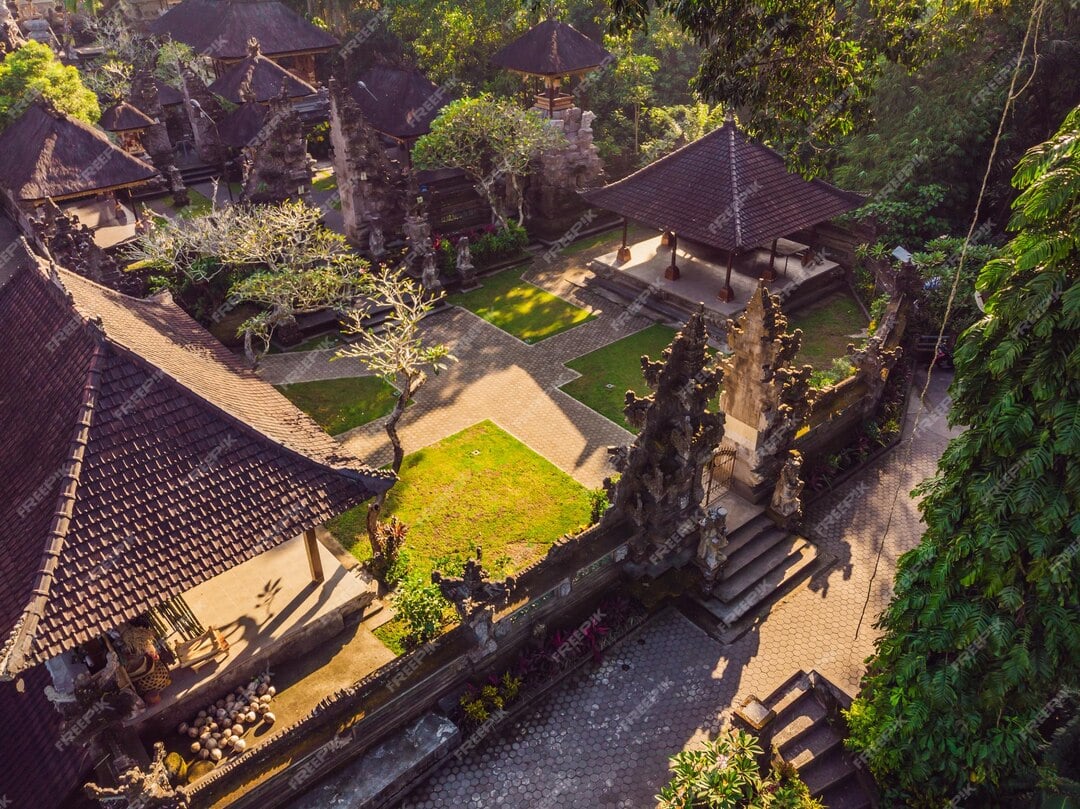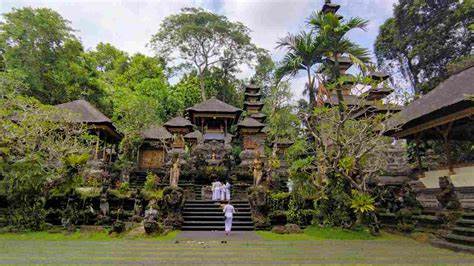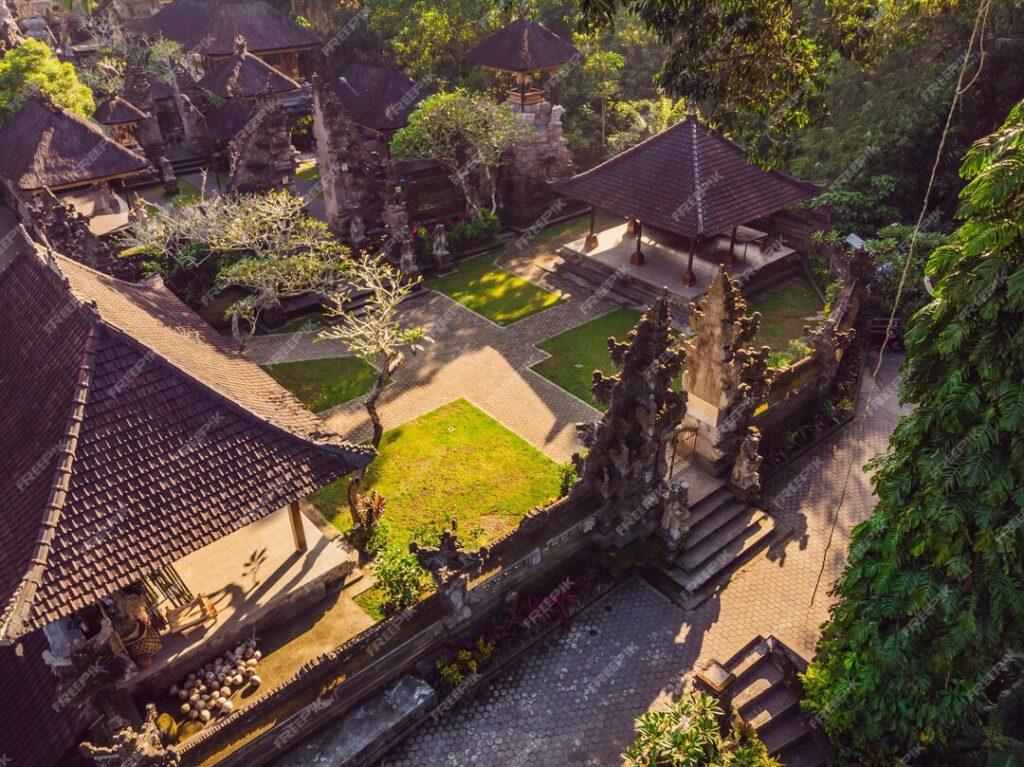Discovering Gunung Lebah Temple

Gunung Lebah Temple. Bali, known as the “Island of the Gods,” is dotted with temples that are not only places of worship but also architectural marvels steeped in history and spirituality. Among these sacred spaces is Gunung Lebah Temple, a hidden gem in the heart of Ubud. Situated at the confluence of the Campuhan and Wos Rivers, this temple is a tranquil retreat, offering a harmonious blend of spirituality, nature, and Balinese culture.
In this article, we’ll explore the history, significance, and visitor experience of Gunung Lebah Temple, and why it is a must-visit destination for those seeking peace and spiritual connection in Bali.
History of Gunung Lebah Temple

The name “Gunung Lebah” translates to “small hill” in Balinese, reflecting the temple’s location on a small elevated area surrounded by dense greenery and flowing rivers. The temple is believed to have been established in the 8th century by Rsi Markandeya, a revered Hindu sage credited with spreading Hinduism in Bali. According to local legend, Rsi Markandeya meditated at this site, drawn by its spiritual energy and serene atmosphere, and established Gunung Lebah as a sacred space for worship and meditation.
Over the centuries, the temple has remained a vital spiritual center for the local community. It is part of the Sad Kahyangan Jagad, a group of six temples considered the spiritual pillars of Bali. These temples are strategically located to maintain balance and harmony across the island, symbolizing Bali’s deep-rooted spiritual connection with nature.
Architectural Beauty
Gunung Lebah Temple is a stunning example of traditional Balinese temple architecture. Its design harmoniously blends with the natural surroundings, creating a serene and mystical atmosphere.
- Entrance Gate (Candi Bentar)
- The temple’s split gate marks the transition from the mundane world to the sacred space. Intricately carved with motifs of deities and nature, it reflects the artistic finesse of Balinese craftsmen.
- Inner Courtyard (Jeroan)
- The most sacred part of the temple, the inner courtyard houses shrines and altars dedicated to Hindu deities. These structures are adorned with carvings, gold accents, and symbolic decorations.
- Multi-Tiered Meru Towers
- The temple features several meru towers, which are multi-tiered shrines symbolizing Mount Meru, the sacred mountain in Hindu cosmology. Each tier represents a level of the spiritual world.
- Stone Carvings and Statues
- Throughout the temple, visitors can admire intricate stone carvings depicting Hindu myths, gods, and natural elements, showcasing the skill and devotion of Balinese artists.
- River and Jungle Surroundings
- The temple is surrounded by the lush greenery of the Campuhan Ridge, with the sound of the nearby rivers enhancing the spiritual ambiance.
Spiritual Significance

Gunung Lebah Temple is dedicated to Shiva, one of the principal deities in Hinduism, and is a place for spiritual cleansing and meditation. It plays a vital role in the spiritual lives of the local community and serves as a center for traditional ceremonies.
- Connection with Nature
- The temple’s location at the confluence of two rivers is symbolic of purification and spiritual balance. Balinese Hindus believe the energy at this site fosters healing and renewal.
- Meditation and Reflection
- The temple has long been a place for meditation and contemplation. Its serene surroundings make it ideal for those seeking peace and a deeper connection with their inner self.
- Role in Local Rituals
- Gunung Lebah Temple is central to many Balinese ceremonies, including Piodalan (temple anniversary celebrations), where devotees gather to offer prayers and blessings.
Visiting Gunung Lebah Temple

- Getting There
- Gunung Lebah Temple is located near the Campuhan Ridge Walk, a popular hiking trail in Ubud. The temple is about a 15-minute walk from the Ubud Palace and easily accessible by car or scooter.
- What to Expect
- Visitors can explore the temple grounds, admire its stunning architecture, and enjoy the peaceful atmosphere. The temple’s proximity to the Campuhan Ridge Walk makes it a perfect spot for relaxation after a scenic trek.
- Dress Code
- Like all temples in Bali, visitors are required to wear a sarong and sash as a sign of respect. These can be rented or borrowed at the temple entrance.
- Best Time to Visit
- Early morning or late afternoon offers cooler temperatures and a quieter experience. Visiting during temple ceremonies provides a unique opportunity to witness Balinese rituals.
- Admission
- Entry is free, but donations are appreciated to help maintain the temple.
Nearby Attractions
Gunung Lebah Temple is surrounded by some of Ubud’s most iconic landmarks, making it easy to include in your itinerary:
- Campuhan Ridge Walk
- A scenic trail offering breathtaking views of rice fields, hills, and valleys. Perfect for a leisurely walk or sunrise trek.
- Ubud Palace
- The historical residence of Ubud’s royal family, showcasing traditional Balinese architecture.
- Ubud Art Market
- A bustling market where visitors can shop for handmade crafts, clothing, and souvenirs.
- Sacred Monkey Forest Sanctuary
- A popular attraction featuring lush greenery and playful long-tailed macaques.
- Tegallalang Rice Terraces
- Stunning terraced rice fields that are a testament to Bali’s agricultural heritage.
Tips for Visiting
- Respect the Sacred Space
- Maintain silence and refrain from touching sacred objects or entering restricted areas unless invited by temple staff.
- Bring an Offering
- Small offerings, such as flowers and incense, are appreciated and can enhance your spiritual experience.
- Combine with Other Activities
- Pair your visit to Gunung Lebah Temple with a trek along the Campuhan Ridge Walk or a stop at nearby cafés and restaurants for a well-rounded day.
Why Visit Gunung Lebah Temple?
Gunung Lebah Temple is more than just a tourist attraction—it’s a place of spiritual rejuvenation and cultural enrichment. Its serene location, rich history, and stunning architecture make it a must-visit destination for those seeking to experience the spiritual heart of Bali. Whether you’re meditating in its peaceful surroundings, admiring its intricate carvings, or simply soaking in the tranquil ambiance, a visit to Gunung Lebah Temple is sure to leave a lasting impression.
Step into this sacred sanctuary and discover the timeless beauty and spirituality of Bali at Gunung Lebah Temple. 🌿










Leave a Review